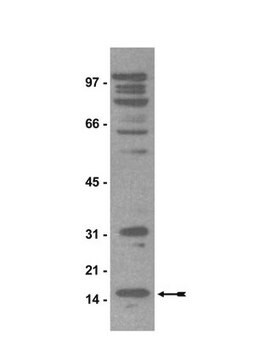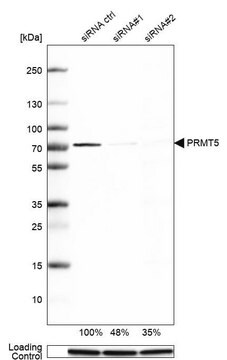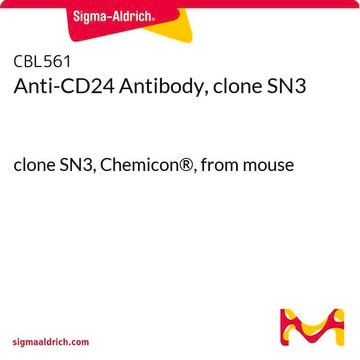07-405
Anti-PRMT5 Antibody
Upstate®, from rabbit
Sinonimo/i:
72 kDa ICln-binding protein, HMT1 hnRNP methyltransferase-like 5, Jak-binding protein 1, SKB1 homolog, SKB1 homolog (S. pombe), Shk1 kinase-binding protein 1 homolog, protein arginine methyltransferase 5, skb1 (S. pombe) homolog
About This Item
Prodotti consigliati
Origine biologica
rabbit
Livello qualitativo
Forma dell’anticorpo
purified immunoglobulin
Tipo di anticorpo
primary antibodies
Clone
polyclonal
Reattività contro le specie
mouse, human
Produttore/marchio commerciale
Upstate®
tecniche
immunoprecipitation (IP): suitable
western blot: suitable
Isotipo
IgG
N° accesso NCBI
N° accesso UniProt
Condizioni di spedizione
wet ice
modifica post-traduzionali bersaglio
unmodified
Informazioni sul gene
human ... PRMT5(10419)
Descrizione generale
Specificità
Immunogeno
Applicazioni
An independent laboratory has reported that this antibody immunoprecipitates active PRMT5 from HeLa cell lysate.
Epigenetics & Nuclear Function
Histones
Qualità
Western Blot Analysis:
0.5-1 μg/mL of this lot detected PRMT5 in RIPA lysates from 3T3/A31, NIH 3T3, HeLa, WI-38, and Jurkat cells.
Descrizione del bersaglio
Linkage
Stato fisico
Stoccaggio e stabilità
Handling Recommendations: Upon receipt, and prior to removing the cap, centrifuge the vial and gently mix the solution. Aliquot into microcentrifuge tubes and store at -20°C. Avoid repeated freeze/thaw cycles, which may damage IgG and affect product performance. Note: Variability in freezer temperatures below -20°C may cause glycerol containing solutions to become frozen during storage.
Risultati analitici
Jurkat cell lysate, HeLa cell lysate.
Included Positive Antigen Control:
Catalog # 12-303, Jurkat lysate. Add 2.5 μL of 2- mercaptoethanol/100 μL of lysate and boil for 5 minutes to reduce the preparation. Load 20 μg of reduced lysate per lane for minigels.
Altre note
Note legali
Esclusione di responsabilità
Non trovi il prodotto giusto?
Prova il nostro Motore di ricerca dei prodotti.
Raccomandato
Codice della classe di stoccaggio
10 - Combustible liquids
Classe di pericolosità dell'acqua (WGK)
WGK 1
Certificati d'analisi (COA)
Cerca il Certificati d'analisi (COA) digitando il numero di lotto/batch corrispondente. I numeri di lotto o di batch sono stampati sull'etichetta dei prodotti dopo la parola ‘Lotto’ o ‘Batch’.
Possiedi già questo prodotto?
I documenti relativi ai prodotti acquistati recentemente sono disponibili nell’Archivio dei documenti.
Il team dei nostri ricercatori vanta grande esperienza in tutte le aree della ricerca quali Life Science, scienza dei materiali, sintesi chimica, cromatografia, discipline analitiche, ecc..
Contatta l'Assistenza Tecnica.








